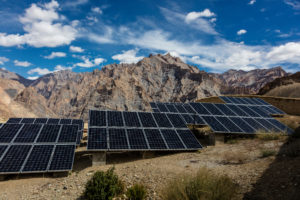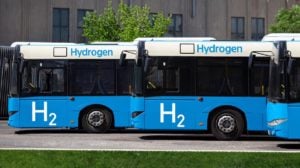The launch of India’s Union Budget, when the finance minister takes the stage carrying her iconic red bag containing the government’s plan for the year, is not just a must-watch for those working in finance. It lays out the country’s priorities for the year ahead in all sectors, from farming to electric mobility, and how much the government is prepared to spend on each of them.
After the latest UN climate talks in Glasgow, when the prime minister promised to put India on track to reach net-zero emissions by 2070 and generate half of the country’s electricity from renewable sources by the end of the decade, Narendra Modi’s administration now faces the question of how to pay for it.
Observers are divided on whether this year’s budget, which increases spending in most areas to help the country recover from two years of pandemic slump, lays a strong enough foundation to kickstart one of the most ambitious decarbonisation efforts ever attempted. But Nirmala Sitharaman, India’s finance minister, definitely intended to send a strong signal in this direction, introducing climate change-related risks as “the strongest negative externalities that affect India and other countries”. Here’s what’s in India’s 2022 budget to help India achieve its climate ambitions, and what’s been missed.
The elephant in the room at India’s 2022 budget
Highly anticipated and notably absent was explicit support for the clean transition of heavily polluting sectors such as steel, cement and heavy-duty transportation, and for the technology touted as able to address the problem: green hydrogen. In India’s 2022 budget, the government announced it will issue its first green bonds, which will encourage businesses to invest in green infrastructure. Poonam Sandhu, a financial sector specialist with the non-profit National Resource Defence Council (NRDC) India, speculates that the green bond scheme might target hydrogen as well as other emerging green technologies. Even so, industry associations that had demanded financial and technical assistance from this year’s budget will be disappointed.
What do the experts say?
When pointing out the shortcomings of this year’s budget speech, Vibhuti Garg, energy economist at the think tank Institute for Energy Economics and Financial Analysis (IEEFA), doesn’t mince her words. “While jargon terms such as energy transition, climate finance and inclusive growth were mentioned multiple times in the budget speech today, the announcements look to have fallen short of promoting clean energy in an accelerated manner,” she said in a statement.
India has set a huge target of 500 GW of non-fossil fuel energy by 2030, and while renewable energy is cost-competitive with fossil fuels, the new technologies will require support, she warned. “The government should have provided a budget allocation and reduction of duties to allow the deployment of rooftop solar, storage, off-shore wind and green hydrogen.” Further, she added, “the budget didn’t include any mention of support for the closure of inefficient fossil fuel plants, nor did it deal with increasing air pollution problems.”
The announcements look to have fallen short of promoting clean energy in an accelerated mannerVibhuti Garg, IEEFA
Solar
The government is serious about getting India ready for the clean energy revolution it promised in Glasgow, which will involve 280GW of installed solar (so far it’s about 43GW). Investor interest on this front is as high as ever, but what India misses is the ability to produce its own solar panels to the scale and quality required for such a leap. So far, the vast majority are imported from China, a leader in solar manufacturing. To reduce import dependence, India has already imposed high custom duties on Chinese components. With the new budget, it’s now ramping up subsidies for the production of high-efficiency PV modules, adding the equivalent of USD 2.61 billion to the existing USD 602 million for the production-linked incentive scheme. While some experts believe cash injections will not be enough to wean India off Chinese imports – because the industry is just not ready – others believe it will make a difference.
What do the experts say?
Rishabh Jain, energy finance expert at the Council on Energy, Environment and Water (CEEW) think tank, is among the optimists. Despite the upcoming custom duties, he says solar tariffs remain low, making it attractive for distribution companies to sign new agreements with clean energy generators. While in 2021 module prices fluctuated, “scaling up integrated solar manufacturing will reduce the instances of disruption leading to greater stability of prices”. The incentives already in place mean 8 GW of solar manufacturing units are already in the pipeline, and with the new much larger injection India should be able to meet domestic demand and compete internationally, Jain says.
Storage
The other missing piece of India’s renewable ecosystem is the ability to integrate intermittent clean energy into the grid. Because solar and wind energy generation fluctuate depending on weather conditions and time of the day, fossil fuels have been deemed necessary to stabilise power flows.
This may change with a massive rollout of batteries, which would be able to store and release clean energy at the right time. This is why the government is making it easier to invest in storage, ahead of the expected storage policy that could come out later this month. Storage systems will now be included in a special ‘harmonised’ list, a catalogue of infrastructures that banks and financial institutions rely on to identify lending opportunities. This, the government hopes, will unlock greater investments in the sector.
Finance
In her speech, the finance minister described climate action as a “sunrise sector”, likely to grow rapidly. She promised to launch special funds for blended finance, using public money to leverage private investments, with a maximum government share of 20%.
In addition, the government’s first green bonds aim to encourage businesses to invest in green infrastructure.
What do the experts say?
Sandhu, the financial sector specialist at NRDC India, explains that the bonds will initially target domestic markets only, and their size will be decided in coordination with the Reserve Bank of India (RBI). Therefore, while they are a welcome move, we still don’t know what they will look like. However, should the green bonds fail to attract enough interest, the green infrastructure plan will go ahead anyway through other forms of borrowing.
Electric vehicles
India has a policy to incentivise the fast adoption of locally made electric vehicles (EVs), particularly motorised rickshaws and buses. So far, this has fallen somewhat flat because, much like solar manufacturers, automakers still largely depend on Chinese imports. This year the government is focussing on the other side of the puzzle: setting up the right infrastructure to accommodate more EVs.
Hopeful adopters are worried about a vehicle’s range – how long they can drive before the batteries run out. Busy cities may not have enough space for a dense network of charging points, so the government is betting on battery swapping, whereby a driver rents a battery instead of owning it, and replaces it when it’s flat for a full one, available at a swapping point. This system cuts charging times and serves tens of vehicles, while a standard charging point only caters to one or two at any given time. In India’s 2022 budget, the government has promised a battery-swapping policy which should encourage the uptake of this system.
What do the experts say?
Sohinder Gill, director-general of industry body the Society of Manufacturers of Electric Vehicles (SMEV), is pleased with the proposal. “Introducing the battery swapping policy […] will help to develop charging infrastructure and increase the use of EVs in public transportation,” he says. “It would motivate businesses engaged in delivery and car aggregation businesses to incorporate EVs into their fleet,” and will encourage more businesses to enter the battery-swapping sector.
Cities and the circular economy
By 2050, half of India’s population is expected to live in cities. Getting today’s cities ready for this future influx is vital. The government has proposed setting up a special urban planning commission and wants to allocate USD 33 million to five academic centres to develop “India-specific knowledge in urban planning and design”.
India’s 2022 budget also promises a bouquet of policies to promote the circular economy, spanning 10 sectors such as electronic waste, end-of-life vehicles, used oil waste, and toxic and hazardous industrial waste.
What do the experts say?
“While a renewed focus on urban planning was one of the key takeaways in the budget,” says Abinash Mohanty, a senior risk and adaptation expert with CEEW, “there was no mention of climate-proofing these investments and infrastructure.” More than 75% of Indian districts, he points out, are extreme event hotspots, “as a result of which India has suffered an annual average loss of USD 87 billion”. The blended climate finance proposed in Sitharaman’s speech, he adds, is insufficient to climate-proof the enhanced investments needed in infrastructure and livelihoods.
This article was first published by Lights On









